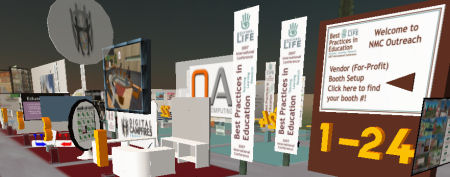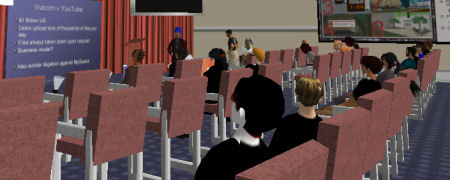Conference: Best Practices in Education
Second Life, 25 May 2007

.
“The future is already here – it’s just unevenly distributed.” This quote from William Gibson was amply illustrated by the first Best Practices in Education Conference to be held in the virtual world Second Life. This international event – presenters and participants were located all around the world – took place on 25 May from 12.00 to 23.00 SLT (Second Life Time), which is equivalent to PDT (Pacific Daylight Time).
There were a number of venues, including the welcome center, the main presentation area (provided by Hyperstring), a second presentation area (Edulsland), a space for vendors and exhibits, and a poster area (Rockcliffe University). The main conference website contains links to the presentation schedule and the conference blog.
I caught parts of Melissa de Zwart’s (SL name – Bramwell Writer) presentation on IP and virtual worlds and Suku Sinnappan’s (SL – Study Writer) presentation entitled Virtual identity and representation. Both were delivered very effectively in live audio, with follow-up questions typed in by audience members. These were followed by the informative Australian Educators’ Panel, in which the panel discussed a variety of issues pertinent to virtual worlds. There seems to be very widespread interest in legal and IP issues, naturally enough given the new terrain that is being broken in virtual worlds – and its uncertain relationship to the legal terrain of the real world.
It was fascinating to be surrounded by a large crowd of delegates whose avatars ranged from those you wouldn’t blink at if you passed them in the street to those at the more striking end of the spectrum, arranged on a continuum from animals to angels. While most delegates sat in the chairs provided during the presentations, there was considerable coming and going – new avatars materialising, others vanishing, still others wandering the rooms – which was entertaining but ultimately also distracting. Clearly, the relationship between RL and SL conference etiquette is also new ground which will need some exploring!
Overall, this conference was a captivating experience. I left with the feeling that those of us lucky enough to attend had been offered a glimpse of Gibson’s unevenly distributed future. See more pix below …

Vendor displays in the Outreach Center

Presentation IP and virtual worlds (de Zwart)

Presentation Virtual identity and representation (Sinnappan)

